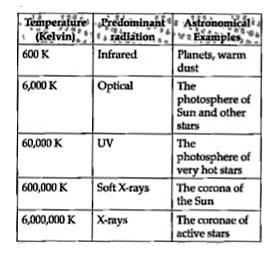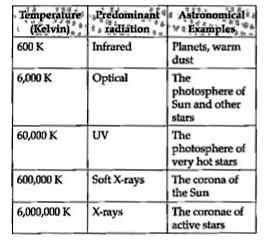The spectrum of distant nebula is taken in an observatory. A shift of 0.025% is observed in the spectral lines. Calculate the velocity of the distant nebula.
The correct Answer is:7.5×104ms−1
To solve the problem of calculating the velocity of a distant nebula based on the observed shift in its spectral lines, we can follow these steps:
1. Understand the Shift in Wavelength:
The problem states that there is a shift of 0.025% in the spectral lines. This shift can be expressed in terms of the natural wavelength (λ) of the light emitted by the nebula.
2. Calculate the Shift in Wavelength (Δλ):
The shift in wavelength (Δλ) can be calculated as:
Δλ=0.025100×λ=0.00025λ
3. Use the Doppler Effect Formula:
The relationship between the shift in wavelength and the velocity (v) of the nebula is given by the formula:
Δλλ=vc
where c is the speed of light (approximately 3×108 m/s).
4. Substitute Δλ into the Formula:
Substitute the expression for Δλ into the Doppler effect formula:
0.00025λλ=vc
This simplifies to:
0.00025=vc
5. Solve for Velocity (v):
Rearranging the equation gives:
v=0.00025×c
Now substitute the value of c:
v=0.00025×3×108 m/s
6. Calculate the Velocity:
Performing the multiplication:
v=0.00025×3=0.00075
Then, multiplying by 108:
v=0.00075×108=7.5×104 m/s
7. Final Result:
The velocity of the distant nebula is:
v=7.5×104 m/s
Final Answer:
The velocity of the distant nebula is 7.5×104 m/s.
The problem states that there is a shift of 0.025% in the spectral lines. This shift can be expressed in terms of the natural wavelength (λ) of the light emitted by the nebula.
The shift in wavelength (Δλ) can be calculated as:
Δλ=0.025100×λ=0.00025λ
The relationship between the shift in wavelength and the velocity (v) of the nebula is given by the formula:
Δλλ=vc
where c is the speed of light (approximately 3×108 m/s).
Substitute the expression for Δλ into the Doppler effect formula:
0.00025λλ=vc
This simplifies to:
0.00025=vc
Rearranging the equation gives:
v=0.00025×c
Now substitute the value of c:
v=0.00025×3×108 m/s
Performing the multiplication:
v=0.00025×3=0.00075
Then, multiplying by 108:
v=0.00075×108=7.5×104 m/s
The velocity of the distant nebula is:
v=7.5×104 m/s
The velocity of the distant nebula is 7.5×104 m/s.
Topper's Solved these Questions
- WAVE OPTICALBook:MODERN PUBLICATIONChapter:WAVE OPTICALExercise:Conceptual Questions
Explore 23 Videos
- WAVE OPTICALBook:MODERN PUBLICATIONChapter:WAVE OPTICALExercise:Tough & Tricky (PROBLEMS)
Explore 7 Videos
- WAVE OPTICALBook:MODERN PUBLICATIONChapter:WAVE OPTICALExercise:PRACTICE PROBLEMS (3)
Explore 10 Videos
- SEMICONDUCTOR ELECTRONICS METERIALS DEVICES AND SIMPLE CIRCUITS Book:MODERN PUBLICATIONChapter:SEMICONDUCTOR ELECTRONICS METERIALS DEVICES AND SIMPLE CIRCUITS Exercise:CHAPTER PRACTICE TEST FOR BOARD EXAMINATION
Explore 12 Videos
Similar Questions
A red shift of 60Å is observed in light of wavelength 5000Å coming from a distant red gaint star. Calculate the velocity of the distant nebula.
View SolutionThe spectral line in the spectrum of light from a star is found to be shifted by 0.032% from its normal position towards the red end of the spectrum . Compute the velocity of the star.
View Solution
Knowledge Check
A star is moving away from earth and shift in spectral line of wavelength 5700Å is 1.90Å. Velocity of the star is :
A50kms−1B70kms−1C80kms−1D100kms−1Read the following text and answer the following questions on the basis of the same:
Spectrum Analysis and Astronomy
Each element in the periodic table can appear in gaseous form and produce its own spectrum unique to that element. Hydrogen will not look like Helium, which wil not look like carbon which will not look like iron....and soon. Astrophysists can identify what kinds of materials are present in stars from the analysis of star's spectra. This type of study is called astronomical spectroscopy. The science of spectroscopy is quite sophisticated. From spectrum lines analysis astrophysists can determine not only the element, but the temperature and density of that element in the star. The spectral line also can tell us about any magnetic field of the star. The width of the line can tell us how fast the material is moving. We can learn about winds in stars from this. The shifting of spectral liens shift back and forth indicates that the star may be orbiting another star. The following table shows a rough guide for the relationship between the temperature of a star and the electromagnetic spectrum.

If the spectrum of a star is red or blue shifted, then it can be used to infer its velocity along the line of sight. Edwin Hubble observed that more distant galaxies tended to have more red shifted spectra. This establishes the theory of expansion of the universe.
From the spectrum analysis the following information of a star can be obtainedAElements present, temperatureBMagnetic field, density, massCdistance of the starDBoth A and BRead the following text and answer the following questions on the basis of the same:
Spectrum Analysis and Astronomy
Each element in the periodic table can appear in gaseous form and produce its own spectrum unique to that element. Hydrogen will not look like Helium, which wil not look like carbon which will not look like iron....and soon. Astrophysists can identify what kinds of materials are present in stars from the analysis of star's spectra. This type of study is called astronomical spectroscopy. The science of spectroscopy is quite sophisticated. From spectrum lines analysis astrophysists can determine not only the element, but the temperature and density of that element in the star. The spectral line also can tell us about any magnetic field of the star. The width of the line can tell us how fast the material is moving. We can learn about winds in stars from this. The shifting of spectral liens shift back and forth indicates that the star may be orbiting another star. The following table shows a rough guide for the relationship between the temperature of a star and the electromagnetic spectrum.

If the spectrum of a star is red or blue shifted, then it can be used to infer its velocity along the line of sight. Edwin Hubble observed that more distant galaxies tended to have more red shifted spectra. This establishes the theory of expansion of the universe.
What may be the approximate temperature if soft X-rays are found predominantly in the spectrum?A60000CB600000CC60000KD600000K
The spectral line of wavelength λ=5000Å in the light coming from a distant star is observed as 5200 Å.Determine the recession velocity of the star.
View SolutionA given element in a star is giving out radiations of certain wavelength.The wavelength , when sighted on earth, has a shift of 0.025 % towards the longer wavelength side.What is the velocity of the star in the line the sight ? Given the velocity of light, c=3×108ms−1.
View SolutionThe spectral line of λ=5000Å in the light coming from a distant star is observed at 5200 Å . Determine the recession velocity of the star.
View SolutionThe wavelength of light coming from a distant galaxy is found to be 0.5% more than that coming from a source on earth. Calculate the velocity of galaxy.
View SolutionRead the following text and answer the following questions on the basis of the same:
Spectrum Analysis and Astronomy
Each element in the periodic table can appear in gaseous form and produce its own spectrum unique to that element. Hydrogen will not look like Helium, which will not look like carbon which will not look like iron....and soon. Astrophysists can identify what kinds of materials are present in stars from the analysis of star's spectra. This type of study is called astronomical spectroscopy. The science of spectroscopy is quite sophisticated. From spectrum lines analysis astrophysists can determine not only the element, but the temperature and density of that element in the star. The spectral line also can tell us about any magnetic field of the star. The width of the line can tell us how fast the material is moving. We can learn about winds in stars from this. The shifting of spectral liens shift back and forth indicates that the star may be orbiting another star. The following table shows a rough guide for the relationship between the temperature of a star and the electromagnetic spectrum.

If the spectrum of a star is red or blue shifted, then it can be used to infer its velocity along the line of sight. Edwin Hubble observed that more distant galaxies tended to have more red shifted spectra. This establishes the theory of expansion of the universe.
Which nature of spectrum establishes the theory of the expanding universe?
View Solution
